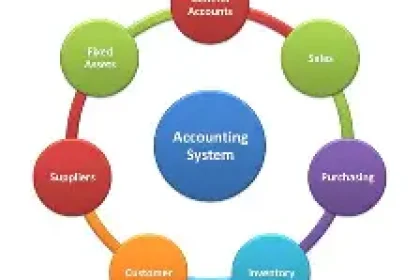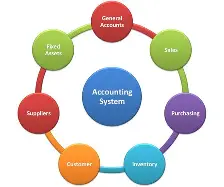

A successful business starts with strong financial management, and at the heart of that lies a reliable accounting system. Whether you’re a growing startup or an established company, having the right tools in place can make the difference between smooth operations and costly errors. In this issue, we break down the top 10 features every accounting system should have to support long-term success. These features include a User-Friendly Interface, Accurate and Real-Time Financial Reporting, Scalability and Customization, Robust Internal Controls, Automated Bank Feeds and Reconciliation, Integrated Payroll and Tax Management, Cloud-Based Access and Data Security, Multi-Entity and Multi-Currency Support, Third-Party Integrations, Compliance and Audit Readiness. Implementing a system that has all these features can help to ensure your business gets accurate, reliable and consistent accounting information on a timely basis.
1. User-Friendly Interface
Simple navigation, intuitive layout, and clear terminology make it accessible to both accountants and non-accountants. Having efficient processes for data entry will help to reduce the time needed to complete your monthly financial close as well as help eliminate the chances of accounting fraud. Ensure you have the necessary data ready to perform the monthly close. Also, ensure you have the right number of accounts set up to adequately breakdown the business activity, use different accounts for frequent or substantial expenditures, use miscellaneous accounts for small expense items. Ensure you have processes in place to follow up on such things as outstanding accounts receivable.
2. Accurate and Real-Time Financial Reporting
Provides up-to-date balance sheets, income statements, and cash flow reports for timely decision-making. An educated accounting team is critical to getting accurate financial information. The team must have the critical accounting knowledge necessary to make the right accounting entries at the right time. They must be able to comprehend changes in the business and accounting regulations that impact the company’s financial statements. Additionally, the team must be able to understand the accounting software such that they can make the correct adjustments to the accounting structure for changes in the business. Most business owners are looking for financial information to help them more effectively manage their business. Having the right financial statements that are accurate, easy to understand and highlight the most important information are critical to the success of the business. Also, having a good set of indicators that accompany the financial statements helps highlight the key issues for the business owner to focus on. This dashboard of indicators is key to the business owner understanding business performance relative to company goals and the competition.
3. Scalability and Customization
Grows with your business and allows customizations like industry-specific chart of accounts or unique reporting formats. A software platform must not only be able to handle your business needs today but it must have the capability to grow with your changing business. Using an established software platform that is updated regularly by the software provider will help ensure the software can handle the needs of your changing business. It can also make it easier to transfer your accounting information to other software platforms and services for such things as payroll and taxes. A robust software platform can really help streamline your accounting processes reducing the time and resources needed to get the information you need.
4. Robust Internal Controls
Includes user roles, audit trails, and approval workflows to minimize errors and prevent fraud. This means clearly defined user roles and permissions to ensure that only authorized personnel can access or edit sensitive financial information. Audit trails are essential, they track every transaction, change, and login so you can trace activity and maintain accountability. Approval workflows for expenses, journal entries, and payments help reduce the risk of mismanagement and enforce financial discipline. By automating these controls, your system supports compliance with regulations such as GAAP or SOX and gives stakeholders confidence in the integrity of your financial data. Having the right checks and balances in place by separating accounting responsibilities can help eliminate accounting errors and reduce the chances of accounting fraud.
5. Automated Bank Feeds and Reconciliation
Connects to bank and credit card accounts to automate transaction imports and simplify reconciliation. A modern accounting system should seamlessly integrate with your bank and credit card accounts to automatically import transactions in real time or on a daily basis. This eliminates the need for manual data entry, reducing the risk of errors and saving valuable time. Once transactions are imported, the system should intelligently categorize them based on predefined rules or past behavior, helping you stay organized and consistent. Automated reconciliation tools then match transactions from your bank with those recorded in your books, flagging any discrepancies for review. This feature not only ensures accuracy but also makes month-end and year-end closings faster and less stressful. In today’s fast-moving financial environment, having up-to-date visibility into your cash position is critical and automated bank feeds are a key part of making that happen.
6. Integrated Payroll and Tax Management
Handles payroll calculations, tax withholdings, and generates necessary tax filings (e.g., W-2s, 1099s, sales tax reports). An effective accounting system should go beyond basic bookkeeping to include seamless payroll and tax functionality. Integrated payroll means your system can automatically calculate wages, withhold the correct amount of taxes, manage benefits, and generate direct deposits all while ensuring compliance with federal, state, and local regulations. It should also handle employer tax obligations such as Social Security, Medicare, unemployment insurance, and workers’ compensation. On the tax side, your system should support automated sales tax tracking, generate accurate 1099s and W-2s, and prepare necessary payroll tax filings and payment reminders. When payroll and tax data sync directly with your financials, you eliminate redundancies, reduce errors, and gain a complete picture of your labor costs and liabilities. This kind of integration saves time, simplifies compliance, and gives business owners peace of mind when it comes to meeting deadlines and staying audit-ready.
7. Cloud-Based Access and Data Security
Enables remote access, data backups, encryption, and multi-factor authentication to protect sensitive financial data. Today’s businesses need flexibility and real-time access to their financial data which is why cloud-based accounting systems have become the gold standard. With cloud access, business owners, accountants, and team members can securely log in from anywhere, on any device, to review reports, manage transactions, or collaborate in real time. This accessibility is especially valuable for remote teams, multi-location businesses, and professionals on the go.
Equally important is the security of that data. A high-quality accounting system should include enterprise-grade encryption, automatic backups, and secure servers to protect sensitive financial information. Features like multi-factor authentication (MFA), user-level access controls, and detailed activity logs help safeguard against unauthorized access and cyber threats. In the event of hardware failure, disaster, or cyberattack, your data remains safe, recoverable, and accessible. Cloud-based systems also stay up to date automatically with the latest security patches and regulatory compliance features, reducing your IT burden. The combination of accessibility and robust data protection ensures that your financial system is not only efficient but also resilient and trustworthy.
8. Multi-Entity and Multi-Currency Support
Supports complex operations across different locations, currencies, and tax jurisdictions if needed. For businesses that operate across multiple locations, divisions, or countries, an accounting system must provide robust multi-entity and multi-currency capabilities. Multi-entity support allows you to manage the finances of different branches, subsidiaries, or business units from a single platform while maintaining separate books, tax IDs, and compliance requirements as needed. This feature enables consolidated reporting, intercompany transactions, and customizable charts of accounts, making it much easier to get a clear picture of your overall business health while still drilling down into each entity’s performance.
On the international side, multi-currency support is essential for businesses that engage in global trade or have customers, vendors, or employees in different countries. A capable system should automatically convert foreign currencies using current exchange rates, track gains and losses from currency fluctuations, and ensure compliance with local financial reporting standards. It should also provide currency-specific reporting so you can analyze performance by region or transaction type. Together, these features eliminate manual conversions, reduce errors, and streamline global operations giving you the tools to grow confidently across markets without compromising financial clarity or control.
9. Third-Party Integrations
Connects seamlessly with CRM, POS, inventory, e-commerce, and other business tools for efficient workflows. A powerful accounting system doesn’t operate in a silo it connects seamlessly with the rest of your business tools to create a streamlined, end-to-end workflow. Third-party integrations allow your accounting software to sync data in real time with systems such as point-of-sale (POS) platforms, customer relationship management (CRM) software, inventory management, e-commerce sites, time tracking tools, project management apps, and more. These connections reduce the need for duplicate data entry, minimize errors, and ensure that information flows automatically between departments.
For example, sales data from your POS or online store can flow directly into your accounting software, while hours logged in a time-tracking app can feed into payroll and job costing modules. CRM integrations help align customer invoicing with your sales pipeline, and project management tools allow for accurate revenue recognition, billing, and budget tracking. With the right integrations in place, your accounting system becomes the central hub of your business operations enhancing efficiency, improving decision-making, and giving you real-time visibility into key financial and operational metrics. In today’s digital business environment, integration is not a luxury it’s a necessity for scaling efficiently and staying competitive.
10. Compliance and Audit Readiness
Keeps you ready for IRS audits, GAAP compliance, and provides documentation and logs for all financial activities. An effective accounting system should do more than track numbers it should help ensure your business stays compliant with evolving financial regulations and is always ready for internal or external audits. Built-in compliance features support adherence to Generally Accepted Accounting Principles (GAAP), International Financial Reporting Standards (IFRS), tax codes, and industry-specific rules. This includes accurate recordkeeping, automated tax calculations, and standardized financial statements that meet regulatory and lender requirements.
Audit readiness means your system maintains detailed records, such as audit trails that log who did what and when, documentation attachments for every transaction, and clearly organized financial reports. During an audit or financial review, this reduces the burden on your team and speeds up the verification process. The system should also support the generation of key compliance documents such as 1099s, W-2s, sales tax filings, and payroll reports with accuracy and consistency. Role-based access and approval workflows further reinforce accountability and segregation of duties both critical components of strong internal controls. Ultimately, an accounting system that supports compliance and audit readiness protects your business from penalties, reduces the risk of fraud or misreporting, and builds trust with investors, lenders, and tax authorities. It brings peace of mind, knowing that your financial house is always in order no matter when the auditors come.
Conclusion
Choosing the right accounting system is more than a technical decision it’s a strategic investment in the future of your business. With the right features in place, you’ll gain greater accuracy, deeper insights, and stronger financial control and improved financial performance. Whether you’re upgrading your current system or starting fresh, make sure these 10 essentials are part of your checklist. Your bottom line will thank you!
Please let us know if you have questions concerning accounting systems or processes or any related topics, we can be reached at (480) 980-3977!




